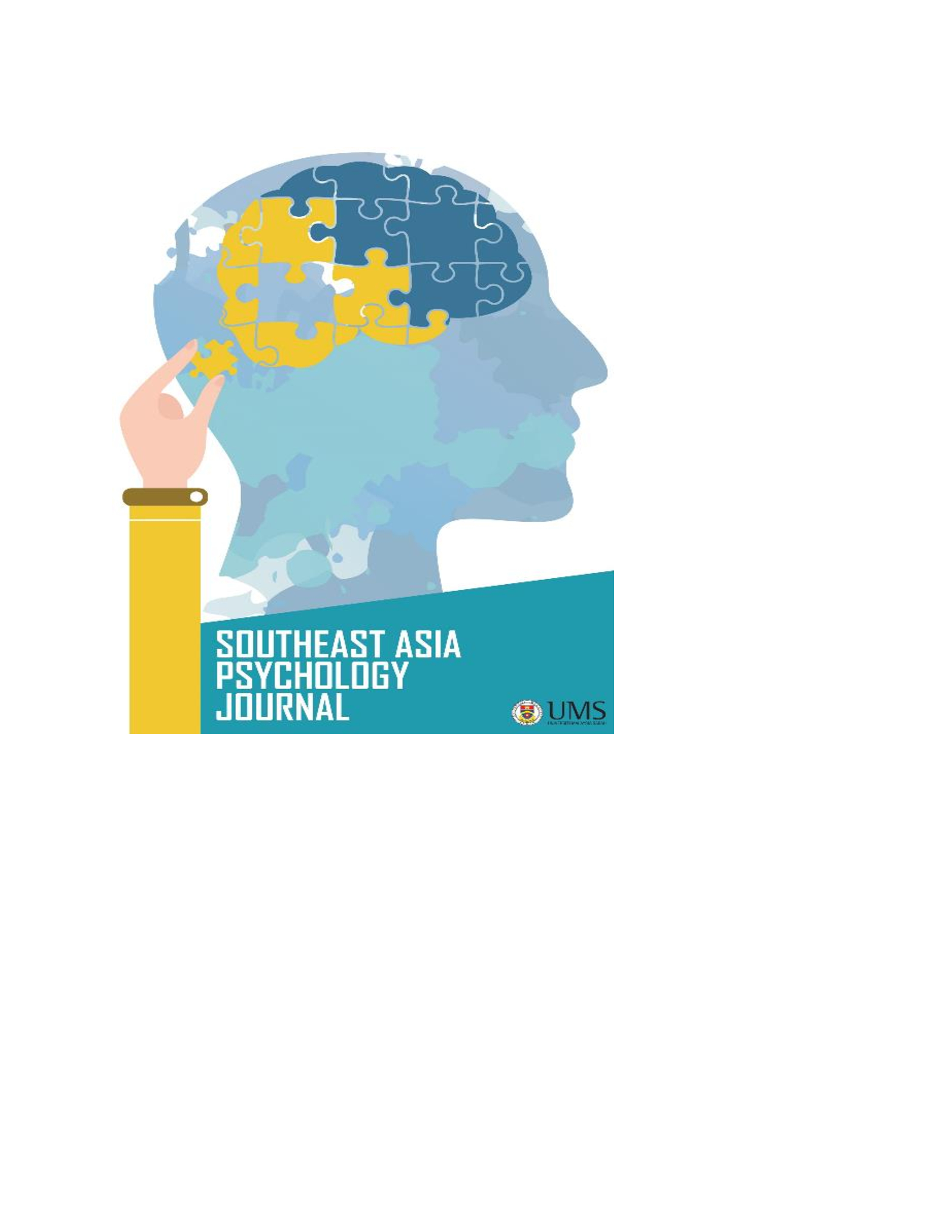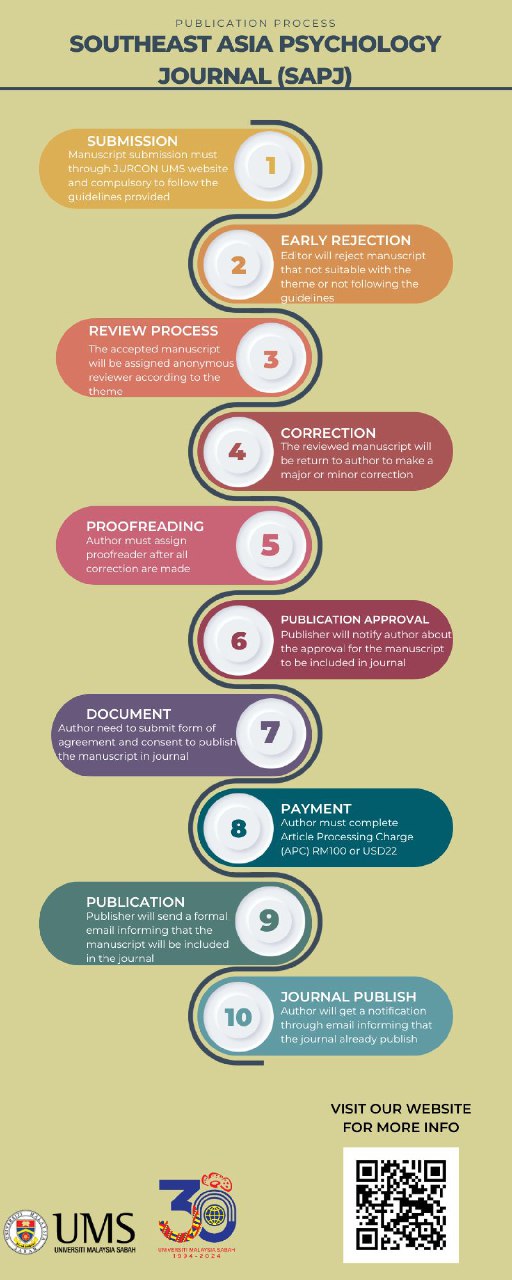Pengaruh Perfeksionisme Dengan Gaya Mengatasi Mahasiswa Di Universiti Awam Malaysia
DOI:
https://doi.org/10.51200/sapj.v12i1.5059Keywords:
Perfeksionisme Adaptif, Perfeksionisme Maladaptive, Gaya Mengatasi Berorientasi Tugas, Gaya Mengatasi Berorientasi Emosi, Gaya Mengatasi Berorientasi Penghindaran.Abstract
Kajian ini bertujuan untuk mengkaji pengaruh antara dua bentuk perfeksionisme (iaitu, perfeksionisme adaptif dan perfeksionisme maladaptif) dan tiga bentuk gaya mengatasi (iaitu, berorientasi tugas, berorientasi emosi, dan berorientasi penghindaran). Kajian ini merupakan kajian kuantitatif dengan penggunaan inventori ataupun soal selidik seperti Adaptive / Maladaptive Perfectionism Scale (AMPS) dan Coping Inventory for Stressful Situation-21 (CISS-21) untuk mengukur perfeksionisme dan gaya mengatasi sampel kajian. Seramai 403 orang pelajar universiti awam Malaysia sebagai responden kajian ini. Data dianalisis dengan menggunakan kaedah regresi linear dalam perisian statistik yang dikenali sebagai IBM SPSS Statistics. Dalam kajian ini, perfeksionisme adaptif ditemukan sebagai peramal yang signifikan terhadap gaya mengatasi berorientasikan tugas, gaya mengatasi berorientasi emosi dan gaya mengatasi berorientasikan penghindaran. Manakala, perfeksionisme maladaptif pula hanya secara signifikan meramalkan gaya mengatasi berorientasi emosi dan berorientasikan tugas, tetapi bukan gaya mengatasi berorientasikan penghindaran. Penemuan kajian ini dapat memberikan gambaran yang jelas kepada kita untuk membantu individu yang berada dalam keadaan tertekan dengan memimpinnya untuk menggunakan gaya mengatasi yang lebih berkesan.
References
Acharya, A. S., Prakash, A., Saxena, P., & Nigam, A. (2013). Sampling: why and how of it? Indian Journal of Medical Specialities, 4(2), 330-333. http://dx.doi.org/10.7713/ijms.2013.0032
Ashby, J. S., & Gnilka, P. B. (2017). Multidimensional perfectionism and perceived stress: Group differences and test of a coping mediation model. Personality and Individual Differences, 119, 106-111. doi: 10.1016/j.paid.2017.07.012
Burns, L. R., & Fedewa, B. A. (2005). Cognitive styles: Links with perfectionistic thinking. Personality and Individual Differences, 38(1),103-113.
Carver, C. S., & Vargas, S. (2011). Stress, coping, and health. In H. S. Friedman (Ed.), The Oxford handbook of health psychology (pp. 165–191). New York, NY: Oxford University Press.
Chang, Y. (2012). The relationship between maladaptive perfectionism with burnout: Testing mediating effect of emotion-focused coping. Personality and Individual Differences,53(5), 635-639. doi: 10.1016/j.paid.2012.05.002
Endler, N. S., & Parker, J. (1990). Coping inventory for stressful situations. Multi-Health systems Incorporated.
Epstein, S. (1994). Manual for the Constructive Thinking Inventory. Unpublished manuscript, University of Massachusetts at Amherst.
Flett, G. L., & Hewitt, P. L. (2002). Perfectionism and maladjustment: An overview of theoretical, definitional, and treatment issues. In G. L. Flett & P. L. Hewitt (Eds.), Perfectionism: Theory, research, and treatment (pp. 5–32). Washington, DC: American Psychological Association.
Flett, G. L., Nepon, T., Hewitt, P. L., & Rose, A. L. (2020). Why Perfectionism Is Antithetical to Mindfulness: a Conceptual and Empirical Analysis and Consideration of Treatment Implications. International Journal of Mental Health and Addiction. doi:10.1007/s11469-020-00252-w
Krejcie, R.V., & Morgan, D.W. (1970). Determining Sample Size for Research Activities. Educational and Psychological Measurement, 30, 607-610.
Larijani, R., & Besharat, M. A. (2010). Perfectionism and coping styles with stress. Procedia-Social and Behavioral Sciences, 5, 623-627. doi: 10.1016/j.sbspro.2010.07.154
Luo, Y., Wang, Z., Zhang, H., Chen, A., & Quan, S. (2016). The effect of perfectionism on school burnout among adolescence: The mediator of self-esteem and coping style. Personality and Individual Differences,88(1),202-208. https://doi.org/10.1016/j.paid.2015.08.056
Mohd Sidik, S., Rampal, L, & Kaneson, N. (2003). Prevalence of emotional disorders among medical students in a Malaysian university. Asia Pacific Family Medicine, 2, 213-217. doi:10.1111/j.1444-1683.2003.00089.x
Mordkowitz, E. R., & Ginsburg, H. P. (1987). Early academic socialization of successful Asian-American college students. Quarterly Newsletter of the Laboratory of Comparative Human Cognition, 9,85–91.
Noble, C. L., Ashby, J. S., & Gnilka, P. B. (2014). Multidimensional perfectionism, coping,and depression: Differential prediction of depression symptoms by perfectionism type. Journal of College Counseling, 17(1), 80-94. doi: 10.1002/j.2161-1882.2014.00049.x
Rice, K. G., & Van Arsdale, A. C. (2010). Perfectionism, perceived stress,drinking to cope, and alcohol-related problems among college students. Journal of Counseling Psychology, 57(4), 439–450. https://doi.org/10.1037/a0020221
Rice, K. G., Kubal, A. E., & Preusser, K. J. (2004). Perfectionism and children’s self-concept: Further validation of the adaptive/maladaptive
perfectionism scale. Psychology in the Schools, 41(3), 279-290.https://doi.org/10.1002/pits.10160
Rice, K. G., Leever, B. A., Noggle, C. A., & Lapsley, D. K. (2007). Perfectionism and depressive symptoms in early adolescence. Psychology in the Schools, 44(2), 139-156. doi: 10.1002/pits.20212
Rice, K. G., & Preusser, K. J. (2002). The Adaptive/Maladaptiveperfectionism scale. Measurement and Evaluation in Counseling and Development, 34(4),210+. https://link.gale.com/apps/doc/A83315368/AONE?u=anon~c0 5bd1a2&sid=googleScholar&xid=bfab6ed7
Safree, M.A., Yasin, M. and Dzulkifli, M.A. (2011). Differences in depression, anxiety and stress between low-and high-achieving students. Journal of Sustainability Science and Management,6, 169-178. http://jssm.umt.edu.my/files/2012/01/19.June11.pdf
Sedwick, P. (2015). Multistage Sampling. BMJ (online), 351. doi: 10.1136/bmj.h4155
Sherina, M.S., Lekhraj, R., & Nadarajan, K. (2003). Prevalence of emotional disorders among medical students in a Malaysia university. Asia Pacific Family Medicine. 2 (4), 213–221.
Slade, P. D., & Owens, R. G. (1998). A dual process model of perfectionism based on reinforcement theory. Behavior Modification, 22(3), 372-390. doi: 10.1177/01454455980223010
Stoeber, J., & Otto, K. (2006). Positive Conceptions of Perfectionism: Approaches, Evidence, Challenges. Personality and Social Psychology Review, 10(4), 295- 319. https://doi.org/10.1207/s15327957pspr1004_2
Stoeber, J., & Rambow, A. (2007). Perfectionism in adolescent school students: Relations with motivation, achievement, and well-being. Personality and Individual Differences, 42(7), 1379-1389.
Stoeber, J., & Rennert, D. (2008). Perfectionism in school teachers: Relations with stress appraisals, coping styles, and burnout. Anxiety,
Stress, and Coping, 21(1), 37-53. https://doi.org/10.1080/10615800701742461
Stoeber, J., & Janssen, D. P. (2011). Perfectionism and coping with daily failures: Positive reframing helps achieve satisfaction at the end of the
day. Anxiety, Stress, & Coping, 24(5), 477-497. https://doi.org/10.1080/10615806.2011.562977
Stoeber, J., Madigan, D. J., & Gonidis, L. (2020). Perfectionism is adaptive
and maladaptive, but what’s the combined effect? Personality and Individual Differences, 161,109846. https://doi.org/10.1016/j.paid.2020.109846
Yee, A. H. (1992). Asians as stereotypes and students: Misperceptions that persist. Educational Psychology Review, 4, 95–132.
Zhang, B., & Cai, T. (2012). Coping styles and self-esteem as mediators of the perfectionism depression relationship among Chinese undergraduates. Social Behavior and Personality: An International Journal, 40(1), 157-168. doi:10.2224/sbp.2012.40.1.157








